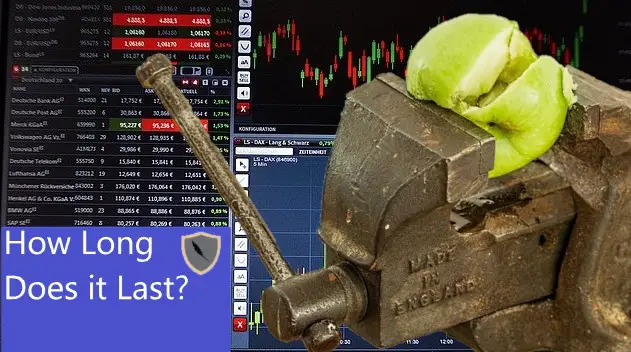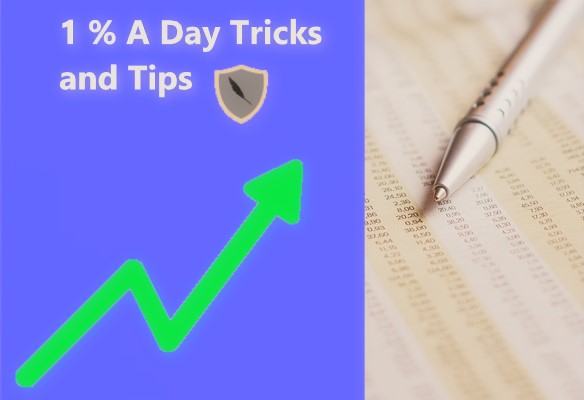Whether you’re a trader or an investor there are ten rules that you need to follow to be successful in the stock market. By sticking to these rules you significantly increase the odds that you will make money in the market. This is because you will clearly define when you should enter, how to size, and when to exit an investment.
The top 10 rules for being successful in the stock market are
- Establishing an investment or trading thesis
- Defining your risk profile
- Sizing your potential investment
- Defining your timeline
- Proper trade placement
- Establishing a hedge
- Removing emotions
- Staying on top of event or volume changes
- Establishing exit price
- Keeping a journal/record of your investments
If you stick to these rules religiously you will come out on top of other traders/investors who fail to do so. This is because these rules will force you to fine tune your approach to the market over time, and as a result will eventually lead you to become a professional investor/trader.
Here at Chronohistoria we are professional investors who teach others how to consistently above average market returns while managing risk. We put out research articles on stocks along with helpful tips and hints. If you like content like this then feel free to subscribe to the newsletter and share this article around.
Without further ado, let’s jump right into the top 10 rules for being successful in the stock market.
Rule 1: Establish an Investment or Trading Thesis
This sounds complex, in reality it’s the opposite. I want you to write down why you think an investment or trade is a good idea. This is called an investment thesis and it is going to help you significantly later on.
An investment thesis can be as simple as “I think that the volume will spike while the stock is bullish, as such I think I can make 10-15% on an intraday trade.”
Or the investment thesis can be incredibly complex such as a recent one we had comparing population growth rates between U.S states to gauge how successful a utility generation company, NextEra Energy ($NEE), was going to be in 2022-2030. (For those interested the article is here)
One of the best places to start building a potential investment thesis is the Securities Exchange Commission. The SEC mandates that all publicly traded companies in the U.S market publish reports outlining their company. Reading these reports is a great way to start to generate ideas. (Source for SEC here)
The important thing is that you write down why you think a stock is going to move in price. This is going to help you establish everything else and over time will help you become a better investor/trader.
The investment thesis does not have to be perfect, but you have to remember to write it down to keep track of it. Practice makes perfect when it comes to these rules.
Rule 2: Define Your Risk Profile
How much are you willing to risk on this trade?
If you have an account worth $100,000 and you’re willing to risk $10,000 on a potential investment/trade then your risk profile on the total investment starts at 10%. Don’t worry, when we get to hedging I will show you who can reduce that number so you’re not risking 100% of the total potential investment.
If you’re super confident in your investment thesis then chances are you are willing to risk a little bit more than 10%. A good example of this would be the ETF SPY.
The SPY is composed of the top 500 U.S companies weighted by market cap. As such its a good match for the overall health of the U.S market. Because of this the SPY has increased by around 10% per year over the past 25 years (outside random events such as the 2020 pandemic).
Investment Thesis: It’s a pretty good bet that the SPY will continue to increase over time. I’m pretty confident in this so I might allocate 15% or more of a total portfolio to the SPY. The risk profile for this investment starts at 15% of the total portfolio.
Just like with the investment thesis, write down your risk profile and why you decided upon this number before you enter an investment/trade. It is going to help you later on when you reflect on your decisions.
Rule 3: Sizing Your Potential Investment
Ok, so now you have your investment thesis and risk profile. It’s time to size a proper investment amount for the trade/investment.
If you buy too many shares you might have problems with liquidity. This is because you overbought and now you can easily sell the shares back to the market without tanking the price.
For normal investors this typically happens in the realm of penny stocks. Here is an example.
As we can see ACIU shot up in the early market hours off investor hype. The problem is that even at its peak volume there were only 200,000 shares being traded per minute.
You should never buy more than 10% of the monthly average trading volume. Which on ACIU before the explosion, would limit you to around 5,000 shares at max.
If you bought more than that then you would turn into a bag holder as you couldn’t sell the shares back to the market without tanking the price. This is because there just would not be enough volume for you to sell even if you wanted to.
As such, always size your potential investment. For the larger stocks such as TSLA, GOOG, AAPL, or MSFT this won’t be a problem. However, if you are day trading smaller stocks make sure you remember this step or you will lose money.
Rule 4: Define Your Timeline
How long do you plan on being in this investment/trade?
Your investment thesis comes into play here. If you think that a stock is going to do “x” by “y” date, then the time from now until that date is your investment timeline.
Write this down, as it will help you emotionally remove yourself from the market. This is because you will be able to look back and say “oh yeah, I said I was going to hold until ‘y’ date happened.“
Writing down your investment/trading timeline will also help you fine tune your approach to investing as it will force you to look for what the professionals call “catalysts” in the market.
A catalyst is something that is going to happen to a stock to influence change. It’s going to happen by “Y” date and as such “X” is going to happen to the underlying stock. The investment thesis is just a larger approach to this investment catalyst idea.
As always, write down your investment timeline. It’s going to help you tremendously if you stick to the timeline.
Rule 5: Proper Trade Placement
We have gone through 4 rules/steps before even placing the trade. Now is when we click buy/sell to start making money. For the example below we are going to be looking at Coinbase.
The goal here is to buy at a good price to limit your downside. Right now Coinbase is trending between $250 and $300 a share. Retail investors typically like to invest off graphs and they add volume to the market so we are going to be placing a trade to benefit from retail trader volume.
The best way to do this is to see previous high’s and low’s in the market. In the above image of Coinbase those “resistance points” are $300 and $250. We want to place a trade when Coinbase’s stock reaches either of those points.
Once the trade has been placed, that line becomes a point of resistance for the stock price to move against. This is because retail traders buy at these points and prevent the stock from moving past. This is a newer effect in the market brought about by the massive influx of newer retail investors.
Still, it’s important that we practice proper trade placement. It takes time to practice but eventually you will be removing initial trading risk by following this tip.
Rule 6: Establishing a Hedge
Ok, here is where we reduce the risk of your total investment amount. This is something almost no retail traders do. Just by learning this step you are going to be well on your way to making money.
A hedge is best defined as a way to bet against yourself to make sure that you stay in the market even if your main investment starts working against you. For example, Hedge Funds were designed for business owners to be able to invest in the market against their own business. So that if their business failed they would have investments that would gain in value. (this is not what hedge funds do now)
Here we are going to be taking a second investment/trade that will gain in value should your first investment/trade begin to fail or go against you.
This is going to take some time to master but what you need to ask yourself is “what will cause my investment/trade to fall in price?” Whatever that thing is you should go invest in it.
This is because as your first investment loses money your second investment will gain in value. This will “keep you in the market” and protect your downside. Here is a handy chart to visualize this.
The above image is of a theoretical perfect hedge, naturally this is near impossible without the aid of algorithms and a little luck. However it does demonstrate how a hedge should work for your investment. As your first investment goes down, your hedge will gain in value. In the above scenario around month 6 your hedge becomes more valuable than your first investment and as such you are still making money.
As a result from hedging your investment your total risk profile on the investment will drop from 100% to around 60-70% (50% on a good hedge).
To find the hedge for your investment you can either use Google or just inverse your investment thesis. Either way should get you on the right track. It takes time and practice, like any other skill.
Rule 7: Removing Emotions
Ok, so we have our investment and it’s hedged. Now we need to remove the human element from the equation.
No investment is going to be perfect. The stock’s price will go up and down constantly, you need to try your hardest to just walk away. Don’t pay attention to it.
Remember that investment thesis and timeline that you wrote down? Go back to those and read them, stick to your guns and you will be fine.
The market is designed to cause people to sell and buy impulsively. Those people are going to lose money and you will gain their loss. It’s vital that you practice the skill of removing your emotions from the market.
If you can’t remove your emotions from the market then you should not be investing to begin with. Emotional investors lose money over the long run.
The best tip I can give you on how to perform this best is just to walk away. If you did all the above mentioned steps properly then you can rest easy knowing that you are going to be ok. Don’t sit at your computer watching the charts unless your investment thesis calls for it.
The world’s best professional traders and investors all know that investing emotionally is the worst thing you can do for your portfolio. Relax and read your notes on the investment timeline and thesis.
Rule 8: Staying On Top of Event or Volume Changes
You need to stay on top of volume or event changes that impact your investment. This does not mean sitting in front of the screen or watching volume like a hawk. Rather this means casually looking for things that will impact your investment thesis and timeline.
For example, let’s say that your investment/trade was expected to release a new product in a month but instead they released it early. Well you might want to sell into the hype since your investment timeline was centered around this product sale.
Or, let’s say that your company failed to deliver on an earnings report. This might change the volume around the stock to the point where you have to sell some of your shares due to liquidity concerns.
You are not watching the stock like a hawk but rather you are keeping up on events that could impact that underlying thesis and timeline for your investment/trade.
Since I am more of an investor than a trader I will check all of my investment’s once a day to make sure they are staying the course. Sometimes however I have an investment perform erratically so I either sell or buy more to remain within my risk profile.
Rule 9: Establishing Exit Price
Ok, so everything went according to plan and now it’s time to exit to take profit. We will never simply liquidate the position but strategically liquidate to maximize return.
Here is where you need to be looking at what professional traders call the level 2 trading screen. The level 2 trading screen is going to give you all of the buy and sell orders currently placed for a stock.
The above image is of the lvl 2 screen in Think or Swim for Coinbase on 09/03/2021 premarket. As we can see there are 100 shares listed under the buying size (BS). If we were going to exit that means we could sell at max 100 shares of COIN for $272 before going down to the next BS at $271.70.
If we sold 200 shares of Coinbase in this lvl 2 screen then we would see the first 100 for $272.00 and the second 100 for $271.70.
You need to be careful when selling as people will attempt to lure you into dropping all of your shares for what you think is a good price but then you sell for much less because you knock out the highest bid price on the lvl 2.
The best way around this is to set what is called a limit order where you will only sell your shares for a limited price, in this case $272.
By doing this you will establish your exit price and the get best possible price for your shares at the current time.
Rule 10: Keeping a Journal/Record of Your Investments
Every trade/investment that you ever do you should keep a record of. This is because over time you will see your progress in following these 10 rules. As a result you will become better and better over time.
There is not one trader or investor on the planet that started as a pro. It takes time, energy, and most importantly dedication to become a professional. There is a ton of stuff to learn in order to get there but by keeping a journal you are already well on your way.
In your journal/record you should write down each of the above ten steps and chart your progress. If done properly you will be able to clearly see where you went wrong on every trade/investment and next time you wont make the same mistake.
Keeping an accurate journal/record of your successful and failed investments is the secret weapon for investing.
Conclusion
There you have it. That is the top 10 rules for being successful in the stock market. If you follow, stick to, and practice the above rules you will become professional over time.
If you like content like this then feel free to subscribe to the newsletter or share around social media. I am here to help others achieve financial freedom and generate above average market returns consistently while managing risk.
Further, you can check out some of our other posts below.
-
How Long Does a Short Squeeze Last? (3 Answers)

What is the time frame for you short squeeze? Well here is everything you will ever need to know to determine how long it will last.
-
Why You Still Own a Stock After It’s Delisted and How to Sell It

Do you still own a stock after its delisted? How do you sell it? Don’t worry the stock is still worth money and here is how to sell.
-
Can You Make 1% A Day in the Stock Market? (3 Steps)

Making 1% a day in the stock market is hard but defiantly doable. Here are 3 simple steps to helping you achieve this return.
Until we meet again, I wish you the best of luck in your investments.
Sincerely,



